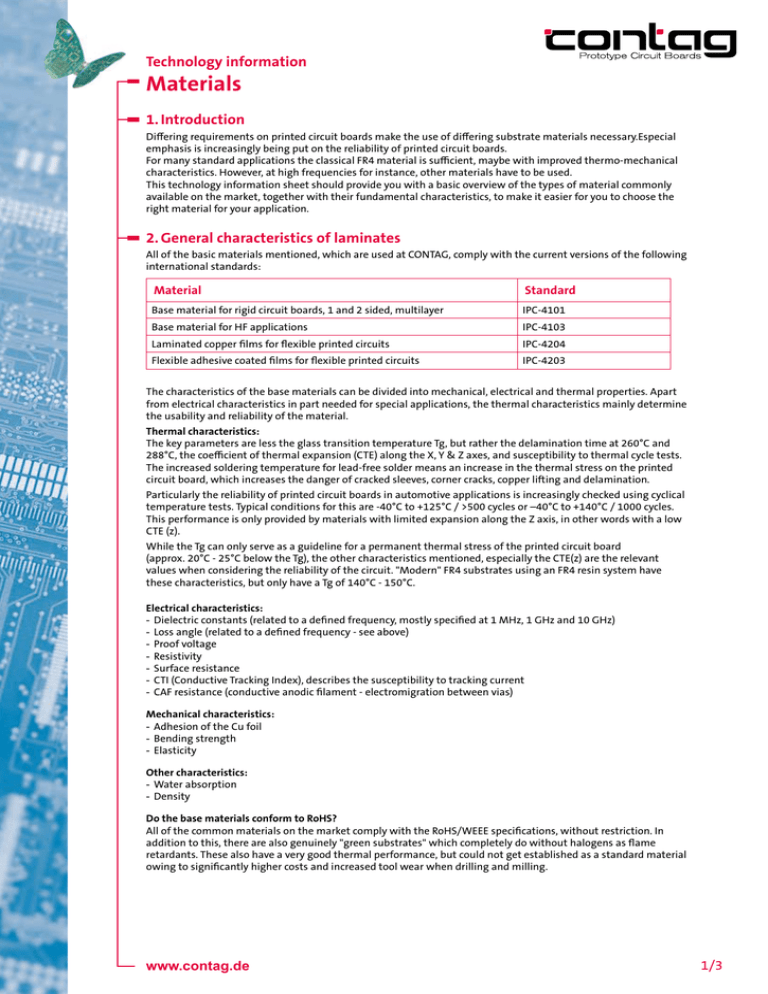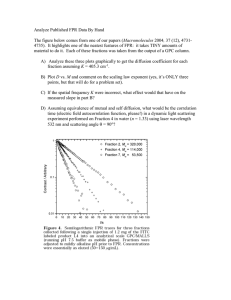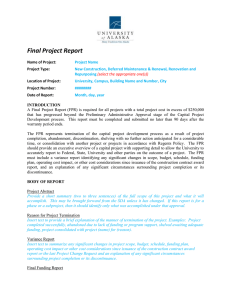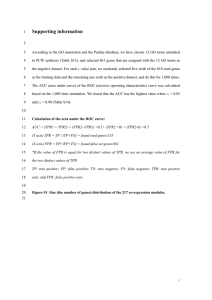Materials - Contag AG
advertisement

Technology information Materials 1.Introduction Differing requirements on printed circuit boards make the use of differing substrate materials necessary.Especial emphasis is increasingly being put on the reliability of printed circuit boards. For many standard applications the classical FR4 material is sufficient, maybe with improved thermo-mechanical characteristics. However, at high frequencies for instance, other materials have to be used. This technology information sheet should provide you with a basic overview of the types of material commonly available on the market, together with their fundamental characteristics, to make it easier for you to choose the right material for your application. 2.General characteristics of laminates All of the basic materials mentioned, which are used at CONTAG, comply with the current versions of the following international standards: Material Standard Base material for rigid circuit boards, 1 and 2 sided, multilayer IPC-4101 Base material for HF applications IPC-4103 Laminated copper films for flexible printed circuits IPC-4204 Flexible adhesive coated films for flexible printed circuits IPC-4203 The characteristics of the base materials can be divided into mechanical, electrical and thermal properties. Apart from electrical characteristics in part needed for special applications, the thermal characteristics mainly determine the usability and reliability of the material. Thermal characteristics: The key parameters are less the glass transition temperature Tg, but rather the delamination time at 260°C and 288°C, the coefficient of thermal expansion (CTE) along the X, Y & Z axes, and susceptibility to thermal cycle tests. The increased soldering temperature for lead-free solder means an increase in the thermal stress on the printed circuit board, which increases the danger of cracked sleeves, corner cracks, copper lifting and delamination. Particularly the reliability of printed circuit boards in automotive applications is increasingly checked using cyclical temperature tests. Typical conditions for this are -40°C to +125°C / >500 cycles or –40°C to +140°C / 1000 cycles. This performance is only provided by materials with limited expansion along the Z axis, in other words with a low CTE (z). While the Tg can only serve as a guideline for a permanent thermal stress of the printed circuit board (approx. 20°C - 25°C below the Tg), the other characteristics mentioned, especially the CTE(z) are the relevant values when considering the reliability of the circuit. "Modern" FR4 substrates using an FR4 resin system have these characteristics, but only have a Tg of 140°C - 150°C. Electrical characteristics: -- Dielectric constants (related to a defined frequency, mostly specified at 1 MHz, 1 GHz and 10 GHz) -- Loss angle (related to a defined frequency - see above) -- Proof voltage -- Resistivity -- Surface resistance -- CTI (Conductive Tracking Index), describes the susceptibility to tracking current -- CAF resistance (conductive anodic filament - electromigration between vias) Mechanical characteristics: -- Adhesion of the Cu foil -- Bending strength -- Elasticity Other characteristics: -- Water absorption -- Density Do the base materials conform to RoHS? All of the common materials on the market comply with the RoHS/WEEE specifications, without restriction. In addition to this, there are also genuinely "green substrates" which completely do without halogens as flame retardants. These also have a very good thermal performance, but could not get established as a standard material owing to significantly higher costs and increased tool wear when drilling and milling. www.contag.de 1/3 3.Values for a few selected typical groups of materials Tg CTEz εr(1 MHz/1 GHz/10 GHz) Proof voltage °C ppm/K - KV/mm MΩ V % N/mm Standard FR4 125°C-140°C <70 4,7/4,3/- 50 10 7 >200 0,06 1,5 Modified FR4 135°C-180°C <55 4,6/4,2/- 45 107 >200 0,06 1,5 FR4 halogen free 150°C-170°C <40 5,0/4,8/4,6 50 8 10 >500 0,06 1,5 BT epoxy Approx. 200°C <40 4,4/4,1/- 70 108 >200 0,05 1,6 CE epoxy Approx. 250°C <25 3,9/3,7/3,5 65 10 >200 0,05 1,6 Polyimide 220°C-260°C <55 4,0/3,8/3,8 45 8 10 >100 0,3 1 PTFE (pure) 200°C-230°C <70 2,6/2,4/2,2 45 107 >600 0,04 1,3 RO3000 - <40 3,0/2,8/2,6 30 107 >600 0,1 2,5 RO4000 Approx. 280°C <45 3,3/3,0/2,8 30 109 >600 0,04 1,0 Materials group Surface Conduc- Water Cu resistance tive Track- absorp- adheing Index tion sion (CTI) 7 4.Example materials for various requirements Standard applications Name Reinforcement Resin Comment Examples Cost factor (reference: FR4 standard) *** FR2 Paper Phenol Low technology, “white goods“, Cobrisol FR2; Aisnot lead-free solderable malibar 0,3 FR3 Paper Epoxy Low technology, “white goods“, Cobrisol FR3; Aisalmost no longer available malibar 0,6 CEM1 Paper Epoxy Low technology Cobrisol CEM1;Aismalibar 0,7 CEM3 Glass mat Epoxy Low technology --- 0,8 FR4Standard Glass Epoxy Tg 130°C-140°C;conforms to RoHS/WEEE MC-100 EX*, R-1766; 1,0 Panasonic FR4halogen free Glass Epoxy Thermally very stable,CAF resistant, Tg >= 150°C DE 156, IS 500; IsolaR-1566W; Panasonic Examples 1,3 Use at high temperatures Name Reinforcement Resin Comment FR4 medium Tg Glass Epoxy Tg approx. 140-160°C, increased R-1755C; Panasonic 1,15 thermal stability, low Z axis ex- IS 400**; Isola pansion, high reliability for leadfree soldering process, often CAF resistant FR4 high Tg Glass Epoxy Tg approx. 160-190°C,see average Tg Rigid PI Glass 5 Polyim- Tg approx. 260°C, high perform- G 200, P 95, ide ance laminate for high reliability P96;Isola N7000 seand high operating temperaries; Nelco tures CE Glass Cyanate Tg approx. 250°C, use is rapidly N8000 series; Nelco 2,5 ester declining, replace by high Tg FR4 and PI materials BT Glass Bismaleimidetriazine resin www.contag.de Cost factor (reference: FR4 standard) *** R-1755S,R-1755T, 1,4 Panasonic, IS 410**, IS 420**, Isola Tg approx. 200°C, very low ther- N5000 series; Nelco 2,5 mal expansion, use is rapidly declining, replace by high Tg FR4 and PI materials 2/3 Controlled impedance & HF applications Name Reinforcement Resin Comment Examples Cost factor (reference: FR4 standard) *** Teflon Ceramic filler PTFE Suited for machining, assembly RO3003®;Rogers of multilayer and hybrid systems possible with FR4 Teflon Glass PTFE Very low εr values, high CTE (z) Polymers Ceramic filler Duro- Suitability for machining is simi- RO4003C®**, 3,5 plast lar to FR4, assembly of multilay- RO4350®**; Rogers, er and hybrid systems possible 25N**; Arlon with FR4 Various Glass Epoxy Low and constant εr values and IS620, IS640; Isola loss angle, high Tg, thermal performance and suitability for machining are similar to FR4 3 4 RT5870®, RT5880®; 3 Rogers Flexible applications Name Reinforcement Resin Comment Examples Cost factor (reference: FR4 standard) *** Polyimide with acrylic adhesive --- --- For dynamic flexible applications, adhesive has a very large CTE(z) Pyralux® LF/FR series**; DuPont 5 Polyimide with epoxy adhesive --- --- For semi-dynamic and static flexible applications Teclam® series*; DuPont Akaflex® series*; Krempel 3 Adhesive free --polyimide --- For dynamic flexible applications, good thermal performance Espanex series*; 5-6 Nippon Steel AP series®**; DuPont LCP (Liquid Crystal Polymer) --- For dynamic, flexible applications, very good thermal performance, low water absorption, also suited for HF applications in the high GHz range R/flex®3600, R/ flex®3850; Rogers --- 8-10 *) Standard material at CONTAG **) Various thicknesses in stock ***) The factors always relate to costs in series production. Material orders for small quantities with short delivery times can lead to delays at CONTAG. 5.Summary There is no universal base material for printed circuit boards. Whether for standard applications, HF, high temperature or other applications: A large number of substrate types is available. For further technological questions concerning circuit boards, please contact our team of technologists (Tel. 030/351 788 – 155). Version: B Issue date: 01.12.2008 3/3


![Anti-IL18R1 antibody [H44] ab140834 Product datasheet 2 Images Overview](http://s2.studylib.net/store/data/012509752_1-759954fe65cc1e6db1842b47812b47ba-300x300.png)
